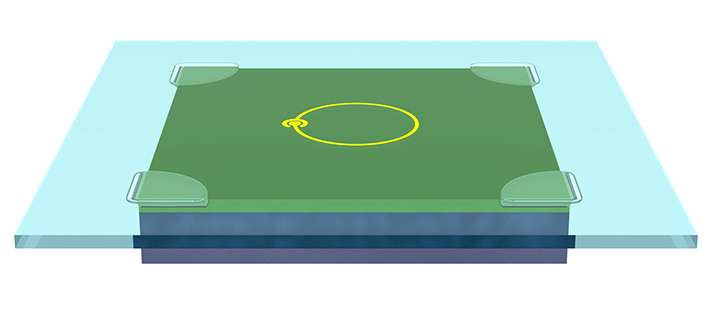Acoustic resonator device paves the way for better communication

Yale researchers have developed a high-frequency version of a device known as an acoustic resonator that could advance the field of quantum computing and information processing.
Hong Tang, Yale's Llewellyn West Jones Jr. Professor of Electrical Engineering & Physics, and his research team, accomplish this with what's also known as a piezo-optomechanical device. It achieves what is known as "a strong coupling" between two systems: a superconducting microwave cavity and a bulk acoustic resonator system. The results appear in the journal Physical Review Letters.
With a strong coupling, the device achieves an exchange of energy and information between the microwave and mechanical resonator systems in a way that exceeds the dissipation—or diminishing energy—of each of the individual systems. That way, information doesn't get lost.
A unique feature of the system is that it operates at the very high frequency of 10 gigahertz. An advantage of a high-frequency system is that it allows for a high signal-processing speed, noted Xu Han, a Ph.D. student in Tang's lab and lead author of the study. "For example, you can convey the same amount of information or message in a shorter time," Han said.
Another advantage is that the high frequency makes it easier to observe quantum phenomena in experiments. In lower frequency devices, the system has to be cooled to extreme temperatures to overcome thermal noise, which comes from random vibrations from the environment that scramble the signal.
One of the potential applications, Han said, is information storage. "If you have a good coupling and exchange between the systems, then you can store information from the microwave domain in the mechanical domain," he said.
Although the experiments weren't conducted under quantum conditions, the researchers note that the high-frequency piezo-electromechanical device is compatible with superconducting qubits—the unit of information analogous to digital bits in conventional computing. That potentially could mean an important step towards hybrid quantum systems, which bridge the world between classical and quantum mechanics, they said.
Han said he is currently building on the technology to develop a device that uses the mechanical system to convert information from the microwave domain to the optical.
"If you want to transmit the information signal, you have to use optics, because optical fiber has very low loss over a long distance," he said.
More information: Xu Han et al. Multimode Strong Coupling in Superconducting Cavity Piezoelectromechanics, Physical Review Letters (2016). DOI: 10.1103/PhysRevLett.117.123603
Journal information: Physical Review Letters
Provided by Yale University





















